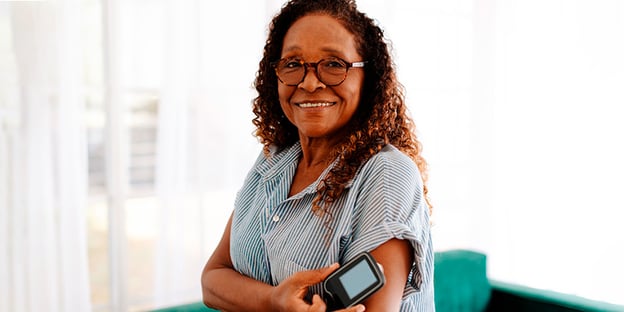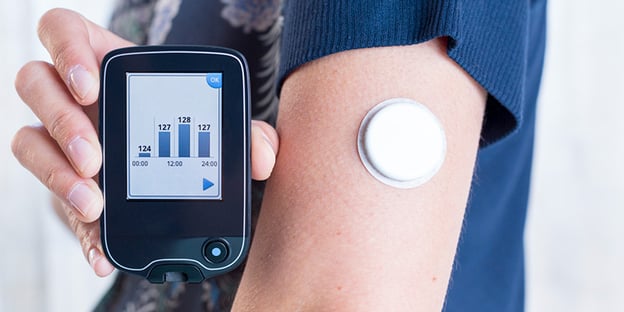Type 2 diabetes patients know one important thing: Staying on top of your blood sugar or blood glucose levels is paramount. So, your daily routine as a Type 2 diabetic probably involves carefully monitoring your diet and making healthy food choices, controlling your stress, working out, and keeping up with your medication all to prevent low blood sugar (hypoglycemia) and high blood sugar, also called hyperglycemia.
But you’ve probably got a handy tool to help with all of this: a glucometer. But if you’re using a traditional glucometer, you’re probably pricking your finger multiple times a day. Not only is that painful, but it’s also inconvenient to do while you’re away from home.
Luckily there are now continuous glucose monitors (CGMs). These devices make it easier to stay on top of your blood sugar. And in the past couple years, they’ve undergone major improvements that make them ideal for those with Type 2 diabetes. Read on to find out which CGM is best for T2 diabetes.
How Continuous Glucose Monitoring (CGM) Technology Works
CGM systems have revolutionized the way patients manage their blood sugar levels. These systems have three main components:
- A small filament attached to a flexible device or sensor that you insert just beneath your skin to monitor glucose levels and provide accurate data throughout the day and evening.
- A transmitter attached to the sensor wirelessly sends glucose readings to a compatible smart device, including your phone, an app, or a receiver made for your specific CGM.
- You can use your smartwatch or smartphone as a receiver, which displays current glucose levels, trends, and alerts.
Enhanced Hypoglycemia and Hyperglycemia Alerts
CGM systems provide real-time alerts when blood sugar levels fall too low (hypoglycemia) or rise too high (hyperglycemia). That way, you can easily avoid low blood sugar, which can cause physical and mental deficits, or high blood sugar, which can make you tired, thirsty, hungry, and irritable.
What’s more? CGMs are customizable to your unique needs. They help you identify personalized target ranges for glucose levels and receive an alert before your levels drop or spike, so you can stop episodes before they start.
Reduced Glycemic Variability
As a type 2 diabetic, you know constantly fluctuating glucose levels can be uncomfortable. Luckily, CGMs can highlight fluctuations that might go unnoticed with traditional monitoring methods like A1C. That way, you and your health care team can adjust your treatment plan to minimize glucose variations and improve your health.
Allowing Caregivers to Help Monitor Blood Sugar
Are you a caregiver for a patient with Type 2 diabetes? You’ll love CGM systems because they allow you to participate in monitoring your patient’s diabetes. That’s especially important for older adults and young children.
Better Quality of Life
CGM systems can also improve overall quality of life for patients with Type 2 diabetes. The most obvious advantage is eliminating the need for fingerstick measurements. That means less mess and embarrassment, especially if you have to do readings in public. Have you forgotten your glucometer before? You won’t have to worry about that again with a CGM worn on your body. You can even buy overpatches to further protect them from the water. This offers much more freedom for patients to focus on enjoying the activities they love.
Another advantage of CGM systems? There are plenty of options to choose from. Here are some of the best models for managing Type 2 diabetes.
Dexcom G6
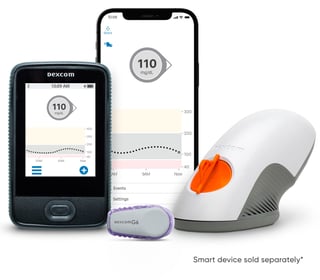 The Dexcom G6 Continuous Glucose Monitoring (CGM) system reports your glucose numbers to a smart device every 5 minutes. Its seven trend arrows show where your numbers are heading and how quickly, so you can make smart choices to help manage your glucose levels. Here’s what patients love about the Dexcom G6:
The Dexcom G6 Continuous Glucose Monitoring (CGM) system reports your glucose numbers to a smart device every 5 minutes. Its seven trend arrows show where your numbers are heading and how quickly, so you can make smart choices to help manage your glucose levels. Here’s what patients love about the Dexcom G6:
- It’s small and discreet, with a sensor usually inserted in your abdomen.
- You can wear it for up to 10 days.
- It lets you view your real-time glucose numbers on your compatible smart device, Dexcom receiver, insulin pump, or health app.
- You can customize alert sounds and settings to best fit your lifestyle.
- You’ll be alerted before your levels spike or drop.
- You can establish your own high and low target levels and be alerted when you reach them.
- Alerts include a 20-minute warning of sugar levels at 55 mg/dL so you can avoid a hypoglycemic event. You’ll also get an alert if you reach that level.
- You can choose a second set of alerts for other situations/needs.
- Overpatches are available.
Dexcom CGM is also great for increasing your time in range (TIR). TIR shows a more complete picture of your glucose variations to AIC alone.
Dexcom G7
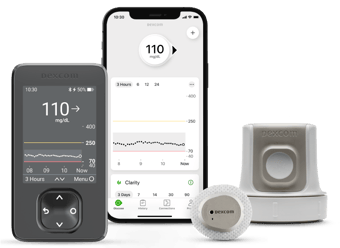 Another great option is the Dexcom G7. Here’s why patients love it:
Another great option is the Dexcom G7. Here’s why patients love it:
- The Dexcom G7 is 60% smaller than the Dexcom G6. Some patients forget they’re wearing it!
- It’s easy to apply, wear, and use.
- You can see your glucose numbers in real time.
- Like the G6, it’s proven to lower A1C and help you spend more time in range.
- Alerts include a 20-minute advance warning of when you’ll reach 55 mg/dL.
- You can mute alert sounds and vibrations for up to 6 hours and delay your first high alert until your reading is high for a period of time you select.
- Quiet mode lets you be alerted by vibrations only, except for urgent alerts, which will make a sound if you don’t acknowledge them.
- G7 can be inserted on the back of the upper arm, the abdomen, or, for children ages 2-17, on the upper buttocks. It can also be inserted using only one hand.
- G7 is more accurate than C6, with a Mean Absolute Relative Difference (MARD) of 8.2% when worn on the upper arm. Comparatively, G6 and Freestyle Libre have MARDs of 9.0% and 9.3%, respectively.
- It allows you to temporarily silence alarms and adjust alert thresholds.
- Available overpatches protect the device during swimming or sweating.
G7 also makes it easier to change sensors, with a warm-up time of just 30 minutes, much shorter than the G6 with the same 10-day lifespan. And when you do need to replace the sensor, there’s no need to worry about saving the transmitter. You can just remove the entire device and insert a new one.
Freestyle Libre 2 System
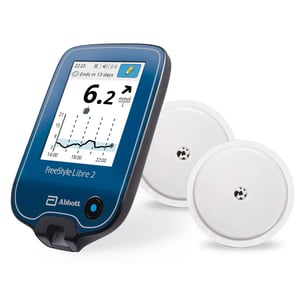 Looking for another option for your CGM? Consider the Freestyle Libre 2. This version has been updated to include optional real-time glucose alarms that alert you when your levels are too low or high. Here are some other reasons to consider it:
Looking for another option for your CGM? Consider the Freestyle Libre 2. This version has been updated to include optional real-time glucose alarms that alert you when your levels are too low or high. Here are some other reasons to consider it:
- Can be used with an Apple or Android smartphone or the Libre 2 app
- Displays blood sugars when the reader is placed next to the sensor
- Records levels every minute for up to 8 hours at a time
- Lasts for 14 days
- Easily inserted
- Has five arrows
- FDA-approved for ages 4 and up
The Freestyle Libre 3 System
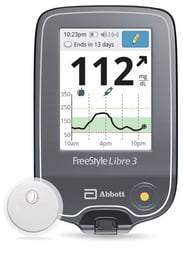
Fans of the Freestyle Libre 2 will love the updated version. This accurate one-piece 14-day CGM system is designed to help reduce time spent in hypoglycemia and improve your overall glucose control.
Here’s what you need to know about the Freestyle Libre 3 system:
- It has the world’s smallest, thinnest, and most discreet sensor – smaller than two stacked pennies.
- It’s simple and painless to apply and wear.
- The optional, real-time glucose alarms let you know immediately when your glucose is too high or too low.
How to Get a Continuous Glucose Monitoring System
Ready to stop pricking your finger and get started with a CGM? We can help. Total Medical Supply is a premier medical supply provider specializing in continuous glucose monitors and supplies, as well as diabetic testing supplies. We’ve made it simple to get a CGM by creating a helpful fact sheet to share with clinicians. Consult with your healthcare provider to determine if a CGM system is suitable for your needs.
Here are the steps to take to advocate for a CGM system:
- Print the CGM Fact Sheet.
- Present the CGM Fact Sheet, using the EHR system or at the next appointment.
- Point out which CGM will work best for your unique needs. Remember, the Dexcom G6 has a 10-day sensor worn on the abdomen and the FreeStyle Libre 2 has a 14-day sensor that’s worn on the back of the arm.
- Ask your doctor for a prescription.
It’s that easy!
Choosing a CGM system can be life-changing for patients with Type 2 diabetes because it offers an easier, more comprehensive, and more convenient way to manage their health and improve their quality of life.
Find out if a CGM is right for you!

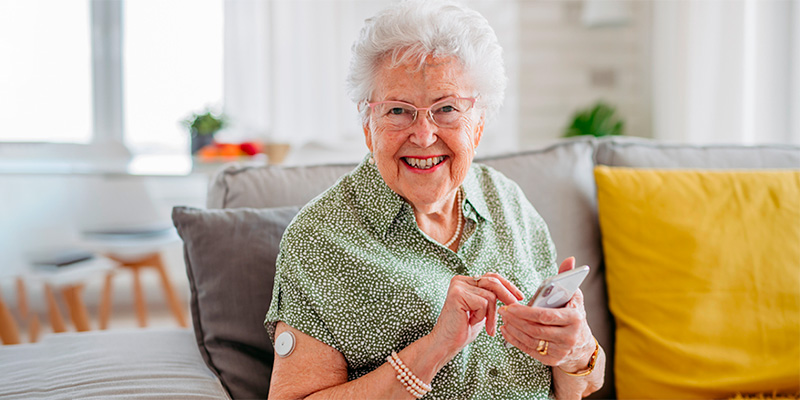

 The Dexcom G6 Continuous Glucose Monitoring (CGM) system reports your glucose numbers to a smart device every 5 minutes. Its seven trend arrows show where your numbers are heading and how quickly, so you can make smart choices to help manage your glucose levels. Here’s what patients love about the Dexcom G6:
The Dexcom G6 Continuous Glucose Monitoring (CGM) system reports your glucose numbers to a smart device every 5 minutes. Its seven trend arrows show where your numbers are heading and how quickly, so you can make smart choices to help manage your glucose levels. Here’s what patients love about the Dexcom G6: Another great option is the Dexcom G7. Here’s why patients love it:
Another great option is the Dexcom G7. Here’s why patients love it: Looking for another option for your CGM? Consider the Freestyle Libre 2. This version has been updated to include optional real-time glucose alarms that alert you when your levels are too low or high. Here are some other reasons to consider it:
Looking for another option for your CGM? Consider the Freestyle Libre 2. This version has been updated to include optional real-time glucose alarms that alert you when your levels are too low or high. Here are some other reasons to consider it:


